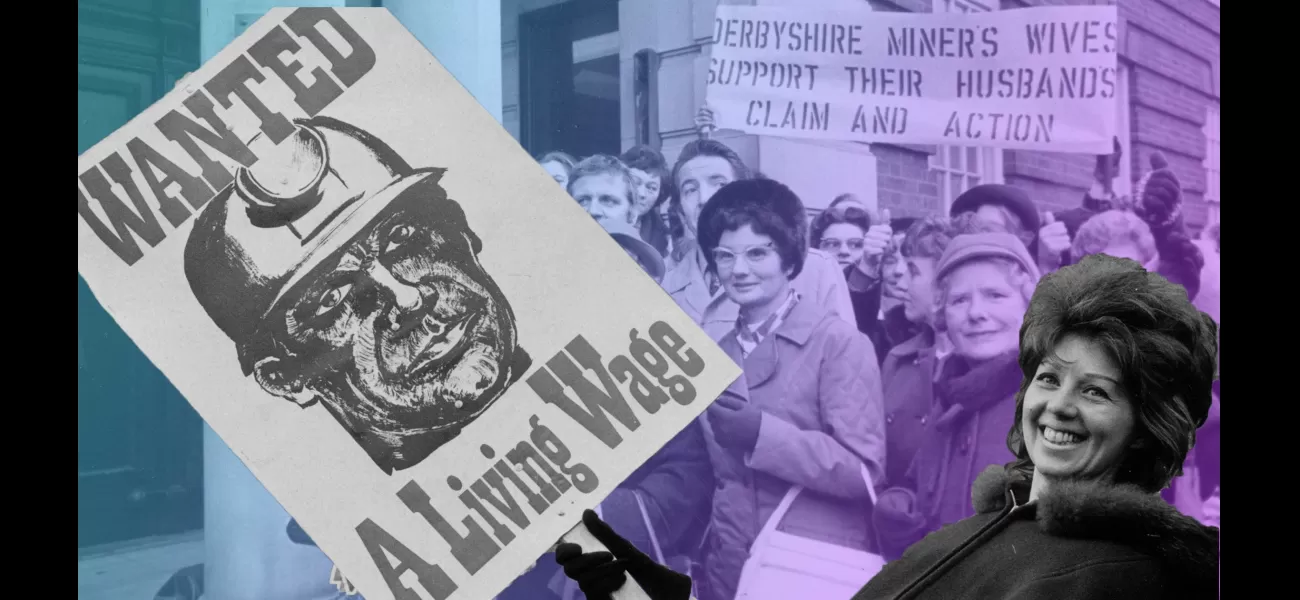Women in Britain had a significant transformation in their societal role due to the impact of the miner's strikes.
40 years ago, women in Britain experienced a significant change in their role due to the Miners' strikes.
March 17th 2024.

The miners' strikes of forty years ago marked a turning point for working-class women in the UK. These women were forced out of their comfort zones and thrust into the forefront of a battle to save their communities. The strikes, which saw over 142,000 miners across England, Scotland, and Wales coming together, were a response to the looming closures of pits that put not only jobs but entire communities at risk.
Taking a stand against the National Coal Board and the Conservative government of Prime Minister Margaret Thatcher, these miners risked losing their livelihoods as they fought for their cause. The strikes became one of the biggest industrial disputes in British history, with some protests even resulting in violent clashes between campaigners and the police. The National Coal Board had its sights set on mines it deemed unprofitable, and when the government announced the closure of 20 collieries in March 1984, the National Union of Miners declared a national strike. This led to picket lines appearing in mining villages and towns all across the country, including Sacriston, a small community in County Durham where Anna Lawson and her family lived.
Now, at the age of 66 and still residing in County Durham, Lawson reflects on the impact of the strikes and how it opened new doors for working-class women like herself. She describes the strikes as a fight for survival, as the closure of the nearest pit would have deemed the village a category D, slated for demolition. In the face of this threat, women banded together to collect food parcels and run soup kitchens for the struggling miners in Doncaster.
According to Lawson, the strikes also marked a significant moment for women in terms of opportunities and empowerment. She highlights how the women's song of "fighting for survival" speaks to the idea that when there is nothing left to lose, one must fight with all their might. The closure of pits continued rapidly after the strikes ended, with only 15 out of 174 remaining open by 1994. This had a devastating impact on coal towns, leaving many families to struggle with mass unemployment. The downfall of the coal industry is still felt in many former mining towns, as they have never fully recovered.
As the mining villages fought for survival and began to crumble, women played a crucial role in keeping their communities together. According to Lawson, women have always had a role in times of emergency, such as when men go off to war. The strikes were no different, and women stepped up to support and empower each other. This was a significant departure from the traditional gender roles that were still ingrained in society, as Lawson explains how even in her own family, she was expected to do the ironing while her brothers had more advanced political views.
For Lawson, taking action against social injustice was second nature, as she was already nicknamed "Anna with the banner" before the strikes. She saw a need and dived in, despite having no idea of the impending closures. During the strikes, she joined the Women Against Pit Closures campaign, which grew into a national movement. As the strikes continued, the women of Sacriston learned how to do things properly, even opening a welfare hub in an empty shop. This was run solely by women, which was not well-received by the men in the community. They also took action to prevent people's electricity from being cut off, which sparked Lawson's interest in welfare law.
After the strikes, many women went on to pursue employment and education opportunities that they may not have considered before. The strikes had shown them that their role in protest was not just about feeding their families, but also about solidarity, education, and communication. This marked a significant shift in society, as women were no longer confined to traditional gender roles and were setting an example for future generations. Lawson herself went on to practice and teach welfare law for a decade, while also continuing her activism.
In conclusion, the miners' strikes of forty years ago not only marked a turning point for working-class women but also created a legacy of protest art and music that continues to inspire women in conflict and struggle all over the world. For Lawson and many others, there was no going back to the convenient stereotypes of the past, and the strikes opened up a world of opportunities and empowerment for women. The women of Sacriston, and all those who took part in the strikes, proved that when faced with adversity, they could come together and create lasting change.
Taking a stand against the National Coal Board and the Conservative government of Prime Minister Margaret Thatcher, these miners risked losing their livelihoods as they fought for their cause. The strikes became one of the biggest industrial disputes in British history, with some protests even resulting in violent clashes between campaigners and the police. The National Coal Board had its sights set on mines it deemed unprofitable, and when the government announced the closure of 20 collieries in March 1984, the National Union of Miners declared a national strike. This led to picket lines appearing in mining villages and towns all across the country, including Sacriston, a small community in County Durham where Anna Lawson and her family lived.
Now, at the age of 66 and still residing in County Durham, Lawson reflects on the impact of the strikes and how it opened new doors for working-class women like herself. She describes the strikes as a fight for survival, as the closure of the nearest pit would have deemed the village a category D, slated for demolition. In the face of this threat, women banded together to collect food parcels and run soup kitchens for the struggling miners in Doncaster.
According to Lawson, the strikes also marked a significant moment for women in terms of opportunities and empowerment. She highlights how the women's song of "fighting for survival" speaks to the idea that when there is nothing left to lose, one must fight with all their might. The closure of pits continued rapidly after the strikes ended, with only 15 out of 174 remaining open by 1994. This had a devastating impact on coal towns, leaving many families to struggle with mass unemployment. The downfall of the coal industry is still felt in many former mining towns, as they have never fully recovered.
As the mining villages fought for survival and began to crumble, women played a crucial role in keeping their communities together. According to Lawson, women have always had a role in times of emergency, such as when men go off to war. The strikes were no different, and women stepped up to support and empower each other. This was a significant departure from the traditional gender roles that were still ingrained in society, as Lawson explains how even in her own family, she was expected to do the ironing while her brothers had more advanced political views.
For Lawson, taking action against social injustice was second nature, as she was already nicknamed "Anna with the banner" before the strikes. She saw a need and dived in, despite having no idea of the impending closures. During the strikes, she joined the Women Against Pit Closures campaign, which grew into a national movement. As the strikes continued, the women of Sacriston learned how to do things properly, even opening a welfare hub in an empty shop. This was run solely by women, which was not well-received by the men in the community. They also took action to prevent people's electricity from being cut off, which sparked Lawson's interest in welfare law.
After the strikes, many women went on to pursue employment and education opportunities that they may not have considered before. The strikes had shown them that their role in protest was not just about feeding their families, but also about solidarity, education, and communication. This marked a significant shift in society, as women were no longer confined to traditional gender roles and were setting an example for future generations. Lawson herself went on to practice and teach welfare law for a decade, while also continuing her activism.
In conclusion, the miners' strikes of forty years ago not only marked a turning point for working-class women but also created a legacy of protest art and music that continues to inspire women in conflict and struggle all over the world. For Lawson and many others, there was no going back to the convenient stereotypes of the past, and the strikes opened up a world of opportunities and empowerment for women. The women of Sacriston, and all those who took part in the strikes, proved that when faced with adversity, they could come together and create lasting change.
[This article has been trending online recently and has been generated with AI. Your feed is customized.]
[Generative AI is experimental.]
0
0
Submit Comment





